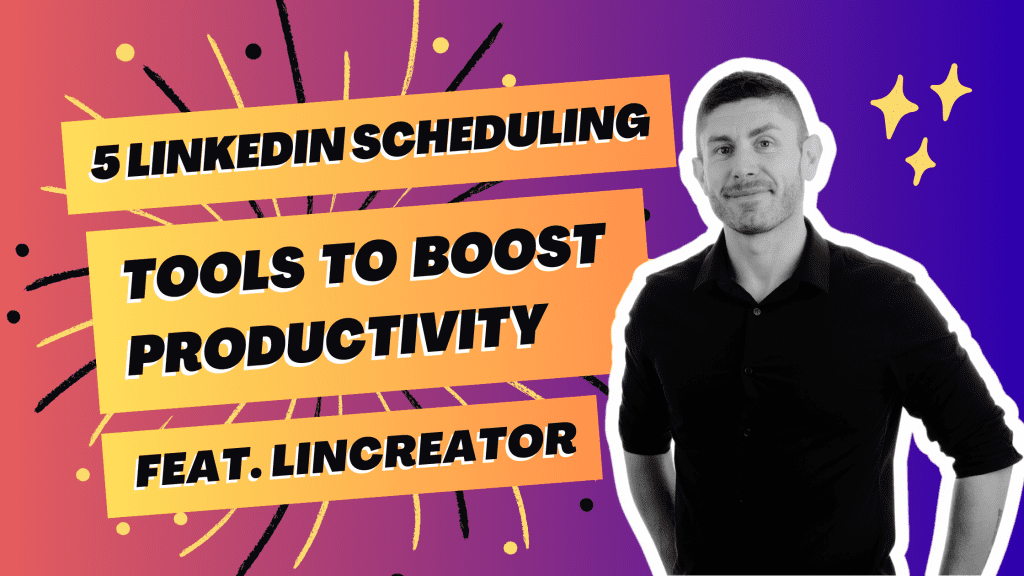In the dynamic world of professional networking, leveraging LinkedIn, a powerful tool for social selling and a key social media management tool, effectively can be a game-changer for businesses and individuals alike. The year 2024 sees an array of sophisticated analytics tools designed to decode social media platforms’ wealth of data, providing strategic insights and reports that drive business success and inform content strategy. These 7 leading LinkedIn analytics tools stand out as critical assets for social selling and track engagement on the platform with precision, offering robust features from trend analysis to social media engagement metrics that align closely with your growth objectives.
As competition intensifies on LinkedIn’s social media platform, harnessing these tools becomes indispensable for crafting informed business strategies and making impactful decisions in social selling. Whether you’re fine-tuning your social media content approach or analyzing audience behaviors for social selling, understanding how each tool elevates your LinkedIn platform performance is paramount in staying ahead in a highly connected marketplace.

Key Takeaways
LinkedIn analytics tools are essential for extracting strategic insights and tailoring your professional networking strategies effectively, as emphasized in the “Understanding LinkedIn Analytics” section.
The “Exploring Use Cases” section highlights that these tools can optimize your content strategy, improve engagement, and enhance your understanding of audience demographics.
As discussed under “Analyzing Tools for Insights,” actionable steps include regularly monitoring key metrics such as engagement rates, follower growth, and content performance to inform your LinkedIn strategy.
The “Leading LinkedIn Analytics Tools in 2024” section provides a curated list of the top tools to consider, reminding readers to select tools that align with their specific business goals and user needs.
“Benefits of Using Analytics Tools” outlines the advantages of data-driven decision-making, including more targeted networking efforts and improved ROI on LinkedIn campaigns.
When choosing the right tool, as guided by “Criteria for Choosing the Right Tool,” look for ease of use, comprehensive reporting features, and budget compatibility to ensure the tool meets your professional needs.
Understanding LinkedIn Analytics
Core Features
LinkedIn analytics tools offer essential features for professionals. They help track engagement and performance on the platform. User-friendly dashboards are central to these tools. They turn complex data into clear visuals. This makes it easier to understand your LinkedIn activities.
These tools also boast integration capabilities with other platforms. For example, they may sync with CRM systems, social media, or marketing software and track interactions using a monitoring tool for social selling. This allows for a more cohesive analysis of online presence and social selling across different channels, including social media, using LinkedIn analytics tools.
How It Works
LinkedIn analytics tools work by collecting and tracking data from profiles, company pages, and social media interactions. The process starts when you engage on LinkedIn—posting content, connecting with others, or participating in groups, using an analytics tool to monitor performance and understand your audience on the social media platform.
An algorithm then analyzes this data with the help of a LinkedIn analytics tool to provide insights about your audience’s behavior and preferences, helping to track your network’s activity. Setting up these tools is typically straightforward, requiring just a few clicks and a helper after signing up to track the pros and cons.
Importance in Social Selling
Analytics, a crucial tool in social selling on LinkedIn, help track performance and offer pro tips for improvement. They help understand buyer behavior through tracking interactions and content engagement using LinkedIn analytics tools; pro tip.
Using these insights from LinkedIn analytics tools can lead to more personalized selling approaches that track customer engagement. For instance, if LinkedIn analytics tool data shows that certain posts resonate well with your audience, you can tailor future content accordingly—pro tip.
This strategic insight tool helps build stronger customer relationships over time.
Exploring Use Cases
Strategic Insights
LinkedIn analytics tools offer deep dives into industry trends. Users can spot patterns that matter in their sectors. This is crucial for staying ahead. For instance, a sudden rise in job postings may signal industry growth.
These tools also enhance competitor analysis. They show how rivals perform on LinkedIn. You see what content works for them and adapt your strategy accordingly. It’s about learning from others’ successes and missteps.
Actionable insights are the end goal here. They help shape marketing tactics to be more effective. Knowing which posts get engagement with the tool informs future content creation decisions.
Social Selling Optimization
Refining outreach tactics is vital on LinkedIn. Analytics tools guide this process by providing data on what resonates with users.
Tool recommendations based on analytics improve engagement rates significantly:
Tailored messaging gets better responses.
Optimal posting times lead to higher visibility.
Content formats preferred by your audience increase interaction.
Tools like tracking metrics over time show social selling success clearly.
Number of connections made each week.
Engagement rate changes month-to-month.
Sales or leads generated through LinkedIn activities.
This long-term view helps adjust strategies as needed for better results.
Lead Generation
Analytics identify high-quality leads effectively:
Active users who engage with similar content often become valuable leads.
People participating in relevant group discussions are likely interested in your offerings.
Conversion rates from various activities are key indicators of success:
Profile visits turning into connection requests indicate strong interest.
Post engagements leading to website clicks suggest compelling content delivery.
Segmenting these leads with a tool enables targeted campaigns that resonate more deeply with potential clients.
Focus messages based on user activity or interests shown on LinkedIn.
Create personalized offers for different segments, increasing conversion chances.
By utilizing 7 leading LinkedIn analytics tools, businesses gain strategic insights essential for growth in 2024 and beyond:
Uncover important trends within specific industries,
Enhance competitor analysis using strategic data,
Shape marketing strategies through actionable insights,
Refine LinkedIn outreach tactics,
Improve engagement rates with tool recommendations,
Track social selling success over time,
Identify high-quality leads via robust analytics capabilities, and
Segment leads effectively for targeted marketing efforts.
Analyzing Tools for Insights
Viewing Campaign Metrics
Campaign metrics are a crucial tool for understanding the impact of your LinkedIn marketing efforts. To access these, you typically navigate through the dashboard of your chosen analytics tool. Here, you will find data reflecting campaign performance. It’s important to focus on metrics like click-through rates, engagement levels, and conversion statistics.
These numbers tell a story about how well your content resonates with the audience. A/B testing results also play a vital role in this narrative. By comparing different versions of campaigns, marketers can pinpoint what works best. Remember that high-performing metrics often indicate successful campaigns.
Monitoring Daily Stats
Keeping an eye on daily stats is key to spotting trends early on. Most analytics tools offer quick-access features that allow users to see recent performance at a glance. This includes updates on likes, shares, and overall engagement.
Some tools even provide alerts or notifications when there’s a significant change in stats—like a sudden spike in profile visits or post interactions. These alerts can help businesses react swiftly to leverage positive trends or address potential issues.
Real-Time Profile Insights
Understanding who views your content and when is essential for crafting impactful LinkedIn strategies. Real-time insights give immediate feedback which can guide decisions about when to post for maximum reach and relevance.
Tools offering real-time analysis present demographic breakdowns of profile visitors as well—a powerful feature for tailoring content more effectively towards specific groups or industries.
Leading LinkedIn Analytics Tools in 2024
Customizing Marketing Reports
LinkedIn analytics tools now offer custom report features. These allow users to focus on specific KPIs. Users can tailor reports to meet their unique business goals. This ensures that the data they collect is relevant and actionable.
For instance, if a company wants to track engagement rates, they can create a report highlighting this metric alone. By doing so, businesses can better understand how users interact with their content.
Many of these tools have drag-and-drop report builders. They make creating custom reports simple and intuitive. Even those without technical skills find it easy to use these features.
Analyzing Word Usage
Understanding word usage on LinkedIn is crucial for visibility. Some tools specialize in evaluating keyword effectiveness within your content.
They help identify which terms are driving traffic and engagement to your profile or posts. For example, if “digital marketing” is a key phrase for your industry, the tool shows how well you’re incorporating it into your updates.
These tools also suggest optimal keywords for profile optimization. This helps increase search visibility on LinkedIn.
The right word choice makes all the difference when appearing in searches by potential clients or employers.
Real-Time Profile Insights
Gaining real-time insights into one’s LinkedIn profile has become easier than ever before with advanced analytics tools available in 2024.
Users get notifications about who viewed their profiles and what actions were taken as a result of viewing them.
This immediate feedback allows professionals to adjust their strategies quickly based on user behavior patterns observed through these insights.
Benefits of Using Analytics Tools
Data-Driven Decision-Making
Analytics tools transform how businesses make decisions. Data-driven strategies increase the chances of success. By analyzing data, companies can focus on marketing efforts that offer the best return on investment (ROI). This approach is more efficient than guessing what might work.
Using historical data patterns, businesses can forecast trends and outcomes. This predictive power helps in planning future campaigns with greater accuracy. For example, if LinkedIn analytics show a particular type of post performs well, it’s smart to create similar content.
Visual representations are also key. They help explain complex data simply. Stakeholders often prefer clear visuals over raw numbers when making important decisions.
Streamlining Lead Generation
Lead generation becomes easier with the right tools. Analytics automate much of this process by qualifying leads for you. The software sorts potential customers based on their actions online.
By tracking engagement levels, sales teams know who to contact first. Those who interact most with your LinkedIn content are likely more interested in your products or services.
This integration saves time and improves lead management efficiency:
Automated qualification processes.
Prioritization based on user engagement.
CRM systems that manage leads effectively.
Enhancing Content Strategy
Content strategy benefits greatly from analytics too. Engagement metrics guide you in creating material that resonates with your audience.
Knowing when users are most active allows for optimized posting schedules. You reach people at times they’re most likely to see and engage with your posts.
Also, adapting content formats is crucial:
Articles may appeal to those seeking detailed information.
Videos attract viewers looking for visual explanations or entertainment.
Short posts could engage users wanting quick updates or insights.
Adapting these formats based on performance ensures better results from your LinkedIn presence.
Criteria for Choosing the Right Tool
Maximizing Marketing Efforts
To get the most from marketing, cross-channel analysis is key. It helps allocate resources where they work best. LinkedIn analytics tools offer this insight. They show how channels perform together.
Optimizing ad spend is another must-do. These tools track conversions to see if ads are worth the cost. This data helps adjust spending for better results.
A deep understanding of your audience boosts campaign success too. LinkedIn analytics provide demographic and behavioral data. Use this to refine who you target with your messages.
Agile Cost Management
Effective cost management requires real-time tracking of marketing expenses. Analytics tools give a clear view of spending versus budget as it happens.
Forecasting capabilities in these tools can prevent overspending before it occurs. They predict future costs so marketers can plan accordingly.
Cost-per-lead metrics are also crucial for financial efficiency improvements. By analyzing these numbers, companies can streamline their advertising investments and boost ROI.
Financial Planning Advantage
Predictive analytics make budget forecasts more accurate for LinkedIn campaigns. Tools that analyze past spending help plan future marketing budgets wisely. Integrating financial performance indicators into business strategies is vital too. It ensures that every dollar spent on LinkedIn works towards overall goals.
Accessing Native LinkedIn Analytics
Basic Metrics and Reports
LinkedIn offers a range of analytics for marketers to track their progress. Impressions and clicks are crucial metrics. They show how often content is seen and interacted with. These numbers help gauge the initial interest in posted material.
Standard reports within LinkedIn analytics tools provide quick assessments. They summarize data into understandable formats. Marketers can see trends at a glance without deep analysis every time.
Benchmarks are also available through these tools. They allow comparison against industry standards. Knowing where you stand helps tailor strategies for better performance.
Campaign Performance Metrics
Certain metrics reflect the health of your LinkedIn campaigns well. The engagement rate is key, showing how much interaction your content gets relative to its reach. High engagement means people find your posts valuable or interesting.
Another important metric is lead quality, indicating if leads are likely to convert into customers or clients based on their interactions with your campaign.
Tools visualize these metrics over different campaigns or timescales, making comparisons easy. This visualization aids in quickly identifying what works best and what doesn’t. Adjustments can be made promptly, enhancing ongoing campaign results significantly.
Free Tools for Profile Analysis
Analyzing Bulk Invite Rates
LinkedIn’s network expansion features allow users to send connection requests en masse. Tracking the acceptance rates of these invites is crucial. It shows how often people accept your invitations. You can see which messages work best this way.
Analyzing response patterns helps too. This lets you optimize invite messaging for better results. You learn what makes people want to connect with you.
Adjusting bulk invitation strategies is important as well. Look at the success rates of different approaches, and change them as needed. Some tactics may work better than others.
For example, if you notice low acceptance rates, try changing your message or targeting a different audience segment.
Post-Performance Monitoring
Monitoring individual post-performance guides your content strategy on LinkedIn. Check how each post does after you share it on your profile.
Evaluating virality factors like shares, comments, and likes is key here too—these show how engaging your posts are with audiences.
Identify the best-performing content types: text, image, or video? Knowing this helps focus on creating more successful posts in those formats.
For instance, if videos get more likes and comments than images do in your industry niche, consider producing more video content moving forward.
Embracing Technology Integration
Seamless Operations
LinkedIn analytics tools are transforming how sales and marketing teams operate. Shared analytics insights allow for a more streamlined workflow. Sales can see what content drives engagement, while marketing learns which leads are most active. This synergy creates a powerful dynamic.
Automated features in these tools reduce manual reporting tasks significantly. Teams can focus on strategy rather than data entry. Reports generate with the click of a button, saving hours each week.
Integration with project management software is another benefit. It ensures that everyone moves in the same direction. Tasks align with insights from LinkedIn analytics seamlessly.
Collaborative Supplier Relationships
Supplier partnerships also improve with LinkedIn analytics tools by sharing performance insights. These shared metrics help enhance supplier relationships greatly.
Objectives between partners align better when based on mutual analytical findings. Decisions become data-driven, leading to stronger strategies and outcomes.
Transparency is key in co-marketing efforts, and shared data fosters this transparency effectively. Suppliers understand campaign performances through real-time data access. This openness builds trust and encourages more collaborative initiatives moving forward.
Closing Thoughts
The landscape of LinkedIn analytics tools in 2024 offers a wealth of strategic insights for professionals aiming to refine their presence and outreach on the platform. These tools, ranging from native LinkedIn features to advanced third-party solutions, provide a robust framework for understanding audience engagement, optimizing content strategy, and driving business growth. Users must select tools that align with their specific needs, considering factors such as functionality, integration capabilities, and cost-effectiveness.
To leverage the full potential of LinkedIn analytics, it is imperative to stay informed about evolving technologies and best practices. Professionals should continually assess the effectiveness of their chosen tools and be ready to adapt to new trends that can enhance their analytical prowess. For those seeking to transform data into actionable insights, exploring these leading analytics tools is a critical step. Embrace the power of data-driven decisions; start your journey with LinkedIn analytics today.
Frequently Asked Questions
What are the leading LinkedIn analytics tools in 2024?
In 2024, the leading LinkedIn analytics tools include advanced platforms that offer comprehensive metrics on profile engagement, audience demographics, and content performance.
Why is understanding LinkedIn Analytics important?
Understanding LinkedIn Analytics is crucial for measuring the impact of your content, optimizing your strategy, and engaging effectively with your network.
How can you access native LinkedIn analytics?
Native LinkedIn analytics can be accessed directly through your account by navigating to your profile or company page’s ‘Analytics’ section.
What criteria should be used to choose a LinkedIn analytics tool for tracking key metrics, assessing social media performance, and conducting competitor analysis?
Criteria for choosing a tool include accuracy of data provided, ease of use, integration capabilities with other software, and cost-effectiveness.
Can I find free tools for analyzing my LinkedIn profile’s page analytics, detailed analytics, and competitor analysis on social networks?
Yes, there are free tools available that provide basic analysis of your personal or company’s LinkedIn profile performance.
What benefits do analytics tools offer for my business on LinkedIn in terms of social media marketing, profile views, and social selling?
Analytics tools offer insights into audience behavior and content effectiveness which help in refining marketing strategies and improving ROI.


































